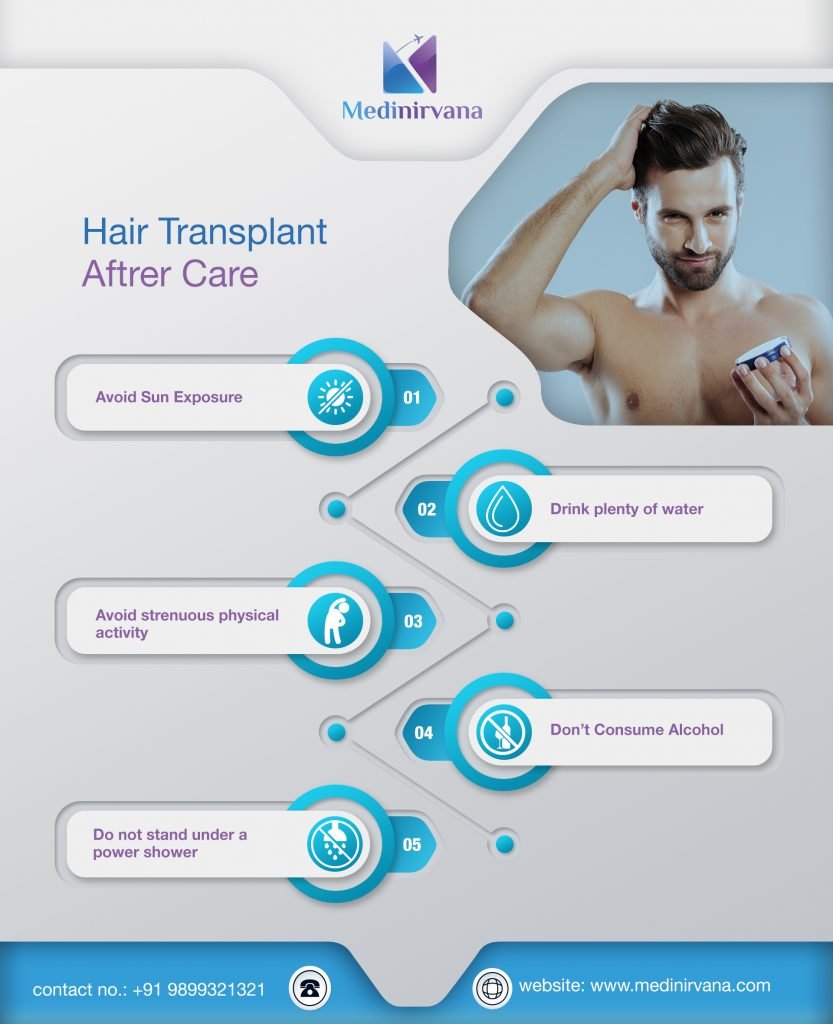It is very common these days to have a hair fall condition. However, if you start noticing bald patches on the scalp, you need to get a hair transplant done, and India is an ideal destination for hair transplant procedure.
If persistent thinning or balding is bothering you and making you question your self-confidence. This cosmetic procedure effectively restores the lost hair and brings back a fuller look to your scalp.
Hair transplant in India is done by skilled professionals and under advanced techniques. If you are planning to undergo the treatment in India, treat this blog as a definitive guide.
Table of Contents
Feel free to skip ahead if one topic catches your eye:
- When is hair transplant needed?
- Your Ultimate Checklist for Hair Transplant in India
- What to expect while considering India for Hair Transplantation?
- What does recovery look like?
- Alternatives for Hair Transplant
- Why choose India for Hair transplantation?
- Cost of Hair transplant in India
1. When is a hair transplant needed?
Hair transplant is not a recommended procedure for every individual and requires many essential factors that need consideration.
If you are experiencing any of the following issues, considering a hair transplant may be a good option.
- If you are experiencing a gradually receding hairline
- If you are witnessing bald patches on the scalp
One of the common errors that people make with hair transplant is mistaking their aging signs with hair loss. It is common for people to age and experience hair loss, so considering a hair transplant might not be the best option if that is the case with you.
Aside from that, the patient also needs to have healthy hair growth on the back of their scalp or the donor site to ensure successful hair growth.
2. Your Ultimate Checklist for Hair Transplant in India
Once you are ready to get your hair transplant done in India, you need to consider important documents and necessary factors. Following is a complete checklist of things that you need to take care of.
-
Make a checklist of the documents:
- Prior consultation papers and previous medical reports
- Scanned photos of the scalp (if you have any)
- Scanned copies of passport (both of the patient and the attendant)
- Residential Address proof
- Proof for the required funds
- Health insurance (if you have any)
-
General Health of the patient
When it comes to a successful hair transplant, the patient’s general health plays a crucial role. If the patient doesn’t have healthy hair growth on the donor site, it would likely result in a failed hair transplant.
From the dietary to lifestyle choices, the patient needs to consider a lot of things. The patient also needs to be on top of their health, well-being, and physical health to quickly sit through the treatment and recovery.
Things to avoid
The common precautionary steps will likely be suggested by the cosmetic surgeon, depending on their overall health and life choices. Generally, the patient needs to avoid smoking and alcohol before the treatment and keep up with their doctor’s suggestions for optimal results.
3. What to expect while considering India for Hair Transplantation?
Undergoing hair transplantation is an extensive process, right from planning to executing it. There are two primary hair transplantation procedures – FUE (Follicular Unit Extraction) and FUT (Follicular Unit Transplantation).
When it comes to the treatment expectations, it is normally divided into three segments – the pre-surgical care, during the treatment, and the post-surgical care.
-
Pre-surgical Care
- The procedure generally starts with a thorough consultation with the cosmetic surgeon who will check your scalp health and your general health
- Once the consultation is done, the doctor will suggest the patient with the best hair transplantation method for them, depending on their hair growth on the donor site
- The surgeon will also suggest the necessary steps involved in preparing for the treatment, including the dietary habits and the things to avoid like smoking and alcohol
During the treatment
- It is done as outpatient surgery at the doctor’s office
- The procedure generally starts by a deep cleansing of the scalp followed by injecting a numbing medication in the scalp
- Depending on the type of procedure that the surgeon has finalized, the patient will then undergo the FUE or FUT hair transplantation
- Once the hair follicles are extracted from the donor site of the scalp, they are then divided into individual grafts and then embedded into the balding patches on the scalp
-
Post-surgical Care
- The patient might experience a very tender scalp after a few hours of the treatment
- The surgeon will suggest wearing bandages over the treated area to avoid risks of infection and to promote faster healing
- Patients also need to take medications for pain and swelling after the treatment. Some even need to complete an antibiotic course after the treatment
- The transplanted hair falls out after 2-3 weeks after the treatment, after which the new hair starts growing from the transplanted site
- The majority of the patients experienced restored hair growth by 60% at the site of the hair transplantation
- Some surgeons even prescribe minoxidil to promote hair growth further
4. What does recovery look like?
The recovery timeline varies from patient to patient. It should generally take about a week for you to get back to your normal day-to-day activities. However, it might vary and take less or more time, depending on the patient’s body’s healing abilities.
The patients generally have to take medications for pain, swelling, and possible infection risks after the treatment. If you witness the transplanted hair falling out after 3-4 weeks, know that it is normal.
Generally, the restored hair growth does take around 6-8 months or more, depending on the scalp’s healing abilities and the success rate of the procedure. In case you experience any signs of tenderness or discomfort even after a few weeks of the treatment, consult your surgeon immediately.

5. Alternatives for Hair Transplant
If you find the hair transplantation procedure too tedious for you, there are a few practical alternatives that the patient might look at and consult your doctor. Some of them include:
PRP Therapy – Platelet-rich plasma therapy is another alternative procedure that involves drawing blood from the patient’s body, which is then processed. The platelet-rich plasma is then injected back into the scalp that promotes further hair regrowth in the long run.
Low-level laser therapy – This procedure uses red light therapy and cold laser therapy to promote the strength of the hair follicles from the root. It involves projecting photons directly into the scalp tissues, which are absorbed by the weak cells in the scalp that later promote hair growth in the site. It is safer and a lot less invasive than hair transplantation, but you don’t have assured hair regrowth.
Cosmetic cover-ups – For the patients looking for temporary alternatives for hair transplantation, wigs, or hairpieces are a few other options. These aren’t permanent procedures, which means that you won’t witness hair regrowth in the site of the bald patches or thinning hair. Instead, you can use these methods to cover up the bald patches for that moment.
Medical treatments like scalp therapy with medicated shampoos and tonics are another alternative to hair transplantation. Medications like finasteride and minoxidil are certified treatments that help restore the lost hair.
You need to consult your cosmetic surgeon to see which treatment is the best option for you if you aren’t ready for hair transplantation.
Why choose India for Hair transplantation?
Other than cost-friendly treatment options, there are a few other reasons why hair transplantation is such a popular cosmetic treatment in the country. Some of the primary factors that make India as a leading country for this procedure include:
- Team of highly skilled and experienced cosmetic surgeons
- Hospitals are equipped with advanced equipment and cutting-edge technology
- Patients get personalized and high-quality service
- Acquiring a medical visa is easy
- Ease of communication
- Proper following of safety guidelines during Covid-19
- Patient confidentiality and privacy
- Expected results
At Medinirvana, all you have to do is reach out to us, and we will get the rest sorted out for you with all the safety protocols and the necessary procedures to help you get immediate treatment.
Cost of Hair transplant in India
Compared to the leading Western countries like the United States, hair transplantation in India is a lot less.
Generally, the entire treatment cost starts from INR 25,000 and can go as high as INR 1,00,000 or more, depending on how many grafts are required for the transplantation.
Moreover, there are a few factors that influence the cost of the treatment, including:
- Type of hair transplant the patient is undergoing
- Charges of the cosmetic surgeon and the hospital
- Accommodation charges for the patient
- Number of grafts required for the procedure
Take Away
If you are planning to get hair transplantation in India, you need to keep in consideration the aforementioned factors. From arranging the medical visa to seeking the right cosmetic surgeon and the hospital, Medinirvana takes care of everything for you. All you need to do is prepare yourself for the treatment and fly out to India.









Leave a Reply